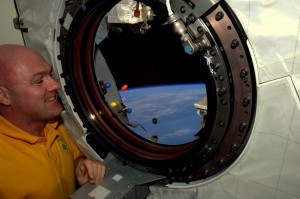Most of the astronauts and cosmonauts aboard the ISS have an amateur radio license. They use the station’s ham radio to contact amateur radio stations on ground mostly in their free time, and the radio is used to contact pre-selected schools. During the ten minutes that the ISS is typically above horizon and radio contact is possible, astronauts answer the questions prepared by the students.
During today’s contact, André will field questions from a group of Dutch children who won the second round of the Ruimteschip Aarde (Spaceship Earth) competition. In this competition André challenged them to research changes on the Earths surface that are noticeable from space: melting of the polar caps, deforestation, desertification and plastic soup in the oceans. To enter the contest they submitted a video about their findings.
The contact will use a telebridge located in Santa Rosa, California. Students will ask as many of following questions as time allows.
1. Jasper Wamsteker. We kunnen je hier wel horen, maar niet zien. Kun je ons beschrijven waar je je nu bevindt? (We can hear you, but not see you. Can you describe where you are right now?)
2. Joey Hut (12). Hoe lang moest u trainen en u voorbereiden voor deze missie? (How long did you have to train and prepare for this mission?)
3. Rowanne van der Raaij (13). Hoe laten ze op aarde de voorbereidende training voor astronaut lijken op hoe het in de ruimte is? (How do they make the training on Earth seem as if you are in space?)
4. Maas van der Reek. Kunt u de atmosfeer zien? Zo Ja, kunt u dan ook het gat in de ozonlaag zien? (Can you see Earth’s atmosphere? If so, can you also see the hole in the ozone layer?)
5. Lars Gerritsen (13). Waardoor werd u geïnspireerd om astronaut te worden? (What inspired you to become an astronaut?)
6. Joris Braster (11). Wat vind u het leukste aan astronaut zijn? (What do you like the most about being an astronaut?)
7. Sterre Klein (13). Als je huilt in de ruimte, wat gebeurt er dan met je tranen? (If you cry in space, what happens to the tears?)
8. Kimberley de Ridder. Hoe verandert de komst van commerciële ruimtevaartuigen de ruimtevaart? (How does the presence of commercial spacecraft change spaceflight?)
9. Robert Kopershoek. Hoe vind je de balans met je lichaam in de ruimte om op 1 plek te blijven, zoals bijv. voor een camera? (How do you manage to balance your body in space to be able to stay in one place, for example in front of a camera?)
10. Mark de Groot (12). Jullie zijn niet voor de lol in de ruimte, maar om experimenten te doen. Zijn er experimenten anders verlopen dan jullie hadden verwacht? (You aren’t in space for fun, but to do experiments. Are there experiments that have gone differently to how you expected?)
11. Nikita Tolokonski, (13). Wat is de maximale tijd op dit moment dat een mens in de ruimte kan doorbrengen? (What is the maximum amount of time a person can spend in space at the moment?)
12. Iris de Vries (12). Hoe komen jullie aan zuurstof in het ISS? (Where do you get oxygen from in the ISS?)
13. Ezra Klok (13). Wat voor gevolgen van de klimaatverandering ziet u vanuit het ISS? (What consequences of climate change do you see from the ISS?)
14. Carsten de Jong (11). Wat doet u als eerste als u weer uit de ruimte terug bent? (What is the first thing you will do when you return from space?)
15. Nick van den Berg. Hoe moet je sportoefeningen, bijvoorbeeld sit ups doen in de ruimte? (How do you exercise in space, for example situps?)
16. Dion in t Veld (11). Waar halen jullie elektriciteit vandaan in het ISS? (Where do you get electricity from in the ISS?)
17. Daan Wijnhorst (13). Wat is uw mooiste herinnering in de ruimte tot nu toe? (What is your best momory in space until now?)
18. Babs de Groot (12). Wat is uw belangrijkste taak aan boord van het ISS? (What is your most important task on board the ISS?)
19. Matthias Meester (13). Wat is er in de toekomst mogelijk aan ruimtereizen? (What kind of spaceflights will be possible in the future?)
This call is made possible by the Amateur Radio in the International Space Station project (ARISS), an international working group, consisting of delegations from nine countries including several countries in Europe as well as Japan, Russia, Canada, and the USA. The organisation is run by volunteers from the national amateur radio organisations and the international AMSAT (Radio Amateur Satellite Corporation) organisations from each country. The volunteers work closely with the national space agencies, including ESA.


Discussion: no comments